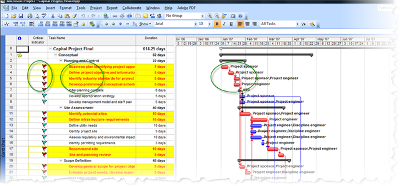Beyond a project schedule hides a very important question: how resilient is this schedule to unavoidable events and surprises? For Large, Complex projects this question is critical, because the resilience of the schedule can vary greatly without the management being aware. In our new White Paper 2013-11 we discuss the notion of resilience and offer some principles to make your project’s schedule more resilient.
 The question is, is it better to have a schedule with a very neat critical path and other chains of events very subcritical, or is it better to have a schedule with many chains of events competing for criticality?
The question is, is it better to have a schedule with a very neat critical path and other chains of events very subcritical, or is it better to have a schedule with many chains of events competing for criticality?
This paper brings together the teachings of White Paper 2013-09 (crude estimates of project overrun) and 2013-10 (what you should really seek when conducting a schedule statistical analysis). It discusses the importance of schedule resilience and gives tip to increase it. For us, it is clearly important to have a schedule with a very clear and resilient critical path on which everybody can focus.
It is now part of Project Value Delivery’s methodology to examine the resilience of a project schedule. It is often possible to improve significantly the schedule’s resilience at minimum cost by some counter-intuitive actions such as starting subcritical chains earlier. The advantages of this practice are numerous; the most notable arguably is to give the project management team a stable focus on a critical path that will not change except in case of major disruption, hence ensuring appropriate decision-making throughout the project.
Read our latest White Paper 2013-11 to understand the concept of schedule resilience and how to use it.

